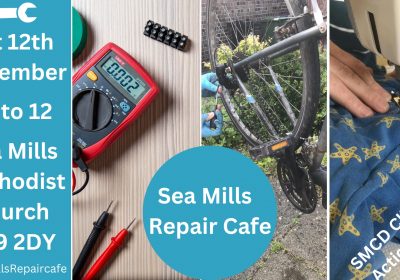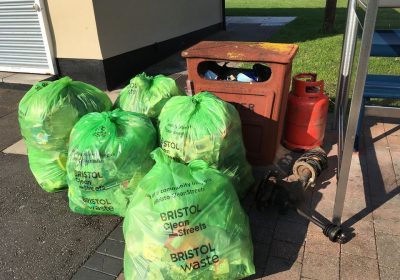Christmas for many has become a consumerist trap to buy more toys, more food, more clothes, more wrapping, more cards, more, more, more. And all of this, every single extra bit of plastic and card and chocolate has an environmental cost.
According to one study, ‘three days of festivities could result in as much as 650 kg of carbon dioxide emissions per person. This is 5.5% of our total annual carbon footprint.’ In just 3 days! And that data is from 2011, I can only imagine it has increased since then.
But – there’s no need to feel guilty about it. Instead, use that knowledge to change some habit. Following on from our ‘craftivism’ ideas in part 1, here are some ways you can make your Christmas a little more earth-friendly.
Wrapping
You may not know that most traditional wrapping paper can not actually be recycled due to its fibres being too short for re-pulping. Plus of course any glitter (and sticky tape) also contaminates the recycling sending the paper to landfill.
Brown paper, printed with inks at home if you like, or coloured on by the kids, and tied up with string or ribbon that can be re-used is a much better alternative but here are some even more ingenious ways of wrapping using recycled goodies you’ll mostly have lying around the house.
Gifts
As Founder of sustainable baby, gift and homeware company, Smallkind, recently said, ‘Living a more sustainable life isn’t so much about what you buy as what you don’t.”. So before we begin searching online for ethical gifts, think first about gift alternatives.
Anything consumable like experiences (like these treasure trails) are a great way to give something meaningful.
If you look up local businesses in your area, you’ll find a lot of great experiences such as BS9 Bristol’s Wot Pots Pottery, Hives and Herbals who do bee-keeper experiences as well as ‘adopt a bee’ gift certificates
And if you get a gift certificate from a local shop like We Make Bristol, you know your gift won’t go unused.
Or how about an Avon Need Trees gift card? Every £10 voucher goes towards 4 metres squared of local woodland.
And for some home made gift ideas, Pinterest is a great place to go for some inspiration.
Food waste
According to Love Food Hate Waste, in the UK we waste the equivalent of more than 4m Christmas meals, including 17.2m sprouts, almost 12m carrots, untold numbers of potatoes and somewhere in the region of 7.4m mince pies (nooo, not mince pies!).
Why does this matter? According to the Food and Agriculture Organisation, in 2007, the global carbon footprint was more than twice the total GHG emissions of all USA road transportation in 2010.
Plus, 74 percent of total annual deforestation (and all of the wildlife – flora and fauna that goes with it) is attributed to food production and seeing as 1/3 of that food goes straight in the bin, food waste contributes devastatingly to biodiversity, which ironically, our food production relies upon.
So here are some super simple tips to reduce your food waste this year.
- Get organised. Before you even get your food shopping this year, sort out your fridge and freezer to make space. While we want to reduce food waste, if there’s stuff in there that already needs to go, get it gone so you don’t end up having to store refrigerable food in the garage and risk it spoiling.
And have a system. Make sure the food that goes off soonest is on a particular shelf- even label it!
- Make a plan. Meal planning is by far the best way to cut out your food waste so plan your meals and snacks. Think about the number of people you’ll be feeding and don’t get caught up with the fear that you may not have enough. If family or friends are visiting, they’re bound to bring food and drink with them (probably to help cut down on their own food waste!).
And guess what? Local small business, Kitchen Titbits has a Christmas meal planning workshop on December 4th. Book now! And if you miss it, there is a great deal of other food waste reduction support offered.
- Write your list and check it twice. Using your meal plan create a proper list of what you need and STICK TO IT. Try not to get sucked into to special offers and buy one get one free deals. They rarely offer much of a saving.
- Keep an eye on the use by dates for foods (remember to organise your fridge), but don’t confuse ‘use by’ dates with ‘best before’ dates. Best before dates are just a rough guide to indicate when food might have gone past its best, but they are very conservative and for most foods, not even necessary. Use your eyes, nose and common sense instead.
- Use up your leftovers. Before I became vegetarian, I used to love the Turkey and ham pie my Aunty made from leftover Christmas dinner, more than the Christmas dinner itself! Here are some creative and healthy recipes to use up the inevitable leftovers.
And perhaps instead of going into Christmas with the food attitude of ,’Oh go on then it’s Christmas’ (we’ve all said it), we could be a little more mindful about how and how much we consume.
You see, so you CAN make a difference. For more ways to reduce your Christmas Carbon footprint, from what tree to buy to making a New Year pledge, read this.
And, as my favourite TV Detective, Columbo often says, ‘There’s just one more thing’. If YOU found this useful the best thing you can do for the planet is to share it with others either by sharing it to your facebook page or emailing it directly to friends and family (perhaps in your ‘round robin’ in lieu of Christmas cards this year?)
Wishing you a greener, happier, healthier Christmas.




